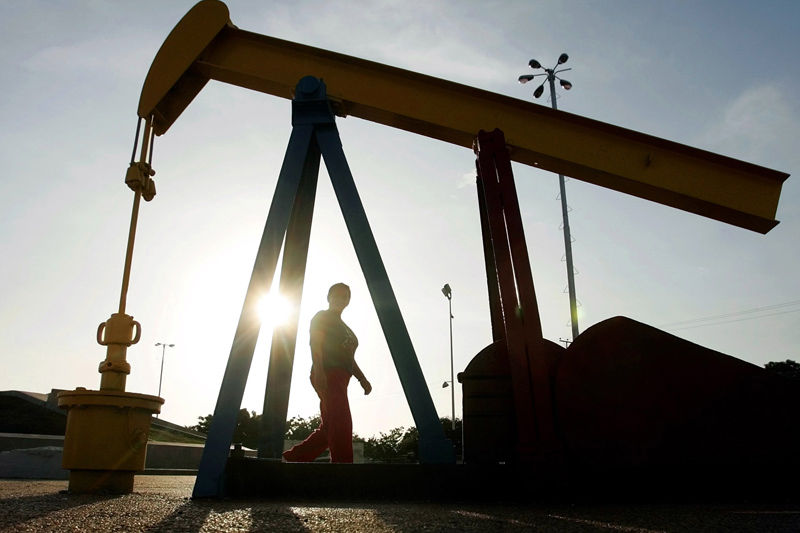Investing.com - Crude oil futures eased lower during U.S. afternoon trade Tuesday, as hopes for near-term monetary easing by China and ongoing concerns over a disruption to supplies from the Middle East failed to outweighed fears over Spain’s deteriorating financial situation.
On the New York Mercantile Exchange, light sweet crude futures for delivery in July traded at USD90.67 a barrel during U.S. afternoon trade, slipping 0.20%.
It earlier advanced by as much as 1.15% to trade at a session high of USD91.86 a barrel. Prices touched USD89.28 a barrel on May 23, the lowest since November 1.
Hopes for fresh monetary easing by China to boost growth in the world’s second largest economy helped support market sentiment. Speculation for near-term monetary easing has been growing after Beijing pledged to speed up approvals for new infrastructure-related projects last week.
Beijing's push to accelerate approvals of infrastructure investments is starting to improve loan demand, a key barometer of China's economic health, the official Shanghai Securities News reported earlier.
Investors have recently been speculating about fresh easing steps and stimulus measures from Beijing to arrest faltering growth in the world's second biggest economy.
China is the world's second largest oil consumer after the U.S. and has been the engine of strengthening demand.
Meanwhile, a lack of resolution in talks between Iran and six world powers over Tehran’s nuclear program late last week provided further support.
A dispute between Iran and the West intensified over the weekend, after Tehran refused to permit the International Atomic Energy Agency from visiting a nuclear site which is suspected of being used to develop nuclear weapons.
The stand-off between Iran and Western countries dominated sentiment in the oil market for the most part of the fourth quarter of last year as well as the first three months of 2012.
However, NYMEX crude prices are off almost 14% in May and have fallen nearly 17.5% since hitting a March 1 intraday peak of USD110.53 a barrel, as concerns lingered over a widening global economic slowdown and as tensions have eased between Iran and Western nations over the country’s nuclear program.
Meanwhile, investors continued to monitor developments surrounding Spain’s debt woes.
Market sentiment softened amid concerns over the situation in Spain, where rising bond yields, the growing costs of bank rescues and a recession hit economy fuelled fears that Madrid will be forced to seek an international bailout.
There are worries that the region’s sovereign debt crisis could trigger a broader economic slowdown that would curb demand for oil. The euro zone accounted for nearly 12% of global oil consumption in 2010, according to data from British Petroleum.
Elsewhere, on the ICE Futures Exchange, Brent oil futures for July delivery rose 0.4% to trade at 107.56 a barrel, with the spread between the Brent and crude contracts standing at USD16.06.
On the New York Mercantile Exchange, light sweet crude futures for delivery in July traded at USD90.67 a barrel during U.S. afternoon trade, slipping 0.20%.
It earlier advanced by as much as 1.15% to trade at a session high of USD91.86 a barrel. Prices touched USD89.28 a barrel on May 23, the lowest since November 1.
Hopes for fresh monetary easing by China to boost growth in the world’s second largest economy helped support market sentiment. Speculation for near-term monetary easing has been growing after Beijing pledged to speed up approvals for new infrastructure-related projects last week.
Beijing's push to accelerate approvals of infrastructure investments is starting to improve loan demand, a key barometer of China's economic health, the official Shanghai Securities News reported earlier.
Investors have recently been speculating about fresh easing steps and stimulus measures from Beijing to arrest faltering growth in the world's second biggest economy.
China is the world's second largest oil consumer after the U.S. and has been the engine of strengthening demand.
Meanwhile, a lack of resolution in talks between Iran and six world powers over Tehran’s nuclear program late last week provided further support.
A dispute between Iran and the West intensified over the weekend, after Tehran refused to permit the International Atomic Energy Agency from visiting a nuclear site which is suspected of being used to develop nuclear weapons.
The stand-off between Iran and Western countries dominated sentiment in the oil market for the most part of the fourth quarter of last year as well as the first three months of 2012.
However, NYMEX crude prices are off almost 14% in May and have fallen nearly 17.5% since hitting a March 1 intraday peak of USD110.53 a barrel, as concerns lingered over a widening global economic slowdown and as tensions have eased between Iran and Western nations over the country’s nuclear program.
Meanwhile, investors continued to monitor developments surrounding Spain’s debt woes.
Market sentiment softened amid concerns over the situation in Spain, where rising bond yields, the growing costs of bank rescues and a recession hit economy fuelled fears that Madrid will be forced to seek an international bailout.
There are worries that the region’s sovereign debt crisis could trigger a broader economic slowdown that would curb demand for oil. The euro zone accounted for nearly 12% of global oil consumption in 2010, according to data from British Petroleum.
Elsewhere, on the ICE Futures Exchange, Brent oil futures for July delivery rose 0.4% to trade at 107.56 a barrel, with the spread between the Brent and crude contracts standing at USD16.06.
